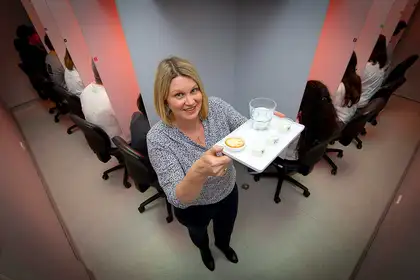
Professor Joanne Hort stands in the existing testing booths located in the Riddet Complex.
Massey University’s Manawatū campus will soon have a state-of-the-art consumer and sensory science facility, to help determine what drives people in their food choice behaviour.
The $2.2 million facility for the Food Experience and Sensory Testing Laboratory, funded by Massey, will sit on the site of the old Ecology Building, alongside the Food Pilot and upcoming Food Science Facility.
College of Sciences Pro-Vice Chancellor Professor Ray Geor says the investment continues to build on the strong food science capability at Massey and in the Manawatū.
“Food science has always been a major focus of the campus and we are continuing to ensure we have the best facilities in the world here for our researchers and for New Zealand companies. The timing of this latest investment is excellent as it coincides with the innovative new ideas, initiatives, and increased collaboration from Manawatū food organisations.”
The facility will increase the already strong food-science presence in Palmerston North from the likes of FoodHQ, Fonterra, AgResearch and Plant and Food Research.
Professor Joanne Hort led the case for the facility as the Fonterra-Riddet chair in consumer and sensory science.
“We are on a journey to becoming a global leader in consumer and sensory science research, and this facility is a big part of allowing us to do that. It will enable the delivery of programmes at the cutting edge of consumer and sensory science research,” Professor Hort says. “Our research is consumer-focused, we seek to understand what people like in food, what influences their enjoyment. As well as understanding the sensory properties of food and beverages, like taste and smell, we can also evaluate perception and how packaging and labelling influences people’s decisions.
“We explore emotional response and contextual effects on food choice and individual variation in perception,” she says.
The facility will have immersive environments where consumers may experience foods in different settings and for different occasions. There will be the capacity to test with mixed and virtual reality and the traditional sensory booths and rooms for focus groups.
Fonterra’s director of research and development, Mark Piper, says that consumer-centric innovation is critical to the success of New Zealand’s value-added agenda to which Fonterra is committed.
“This world-class facility is an important part of the solution in delivering this and should be a cornerstone of Massey’s credentials as a leading food science university.”
Riddet Institute deputy director Professor Warren McNabb says the facility is highly-anticipated.
“The laboratory is very important to the future research direction of the Riddet Institute, one of New Zealand’s Centres of Research Excellence. To be able to link sensory perception to consumer decisions right through to the digestion of food is fundamental to the future of the food industry in New Zealand.”
Professor Hort’s research team, established last year, has been busy working on projects for Riddet, the FoodPilot and the Ministry of Business, Innovation and Enterprise. These have involved establishing expert sensory evaluation panels and a consumer database of participants made up of members of the public who have so far been instrumental in researching dairy products, meats, and New Zealand-made gin.
Other projects include student-led work to examine the impact of context on how people respond to eating snack foods. It achieves this by comparing the experience of eating snack foods in a real and a traditional sensory environment, with a mixed reality environment which provides a virtual experience of their surroundings via a HoloLens.
“Our new facilities will be an asset for consumer-centric food companies developing new foods for New Zealanders and export markets,” Professor Hort says.
“We’re growing our capabilities by the day with the cooperation of many organisations all committed to producing the best food. A big part of what we are doing is putting consumers at the centre of food product design ensuring foods are good for health, meet what’s wanted in international markets and, importantly, means people enjoy their food.”